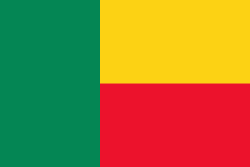Donga Department (Donga)
Donga is one of the twelve departments of Benin; its capital is Djougou, the fourth largest city in the country. The department of Donga was created in 1999 when it was split off from Atakora Department. Donga is subdivided into five communes, each centered at one of the principal towns: Bassila, Copargo, Djougou Rural, Djougou Urban and Ouaké.
, the total population of the department was 543,130, with 270,754 males and 272,376 females. The proportion of women was 50.10%. The total rural population was 57.90%, while the urban population was 42.10%. The total labour force in the department was 120,021, of which 24.20% were women. The proportion of households with no level of education was 72.50%.
Donga Department, with an area of 10691 sqkm, is located in north-central Benin, bordering Atakora Department to the north, Borgou Department to the east, Collines Department to the south, and Togo to the west. The northwest region of Benin consists mostly of forested mountains, from which two tributaries of the Niger River, the Mékrou River and the Pendjari River, originate. Mont Sokbaro, widely cited as the highest point of Benin, lies on the border of Donga Department with Togo. The northern regions of Benin receive one season of rainfall from May to September, while the southern regions receive two spells of rain from March to July and September to November. The country receives an average annual rainfall of around 1200 mm.
, the total population of the department was 543,130, with 270,754 males and 272,376 females. The proportion of women was 50.10%. The total rural population was 57.90%, while the urban population was 42.10%. The total labour force in the department was 120,021, of which 24.20% were women. The proportion of households with no level of education was 72.50%.
Donga Department, with an area of 10691 sqkm, is located in north-central Benin, bordering Atakora Department to the north, Borgou Department to the east, Collines Department to the south, and Togo to the west. The northwest region of Benin consists mostly of forested mountains, from which two tributaries of the Niger River, the Mékrou River and the Pendjari River, originate. Mont Sokbaro, widely cited as the highest point of Benin, lies on the border of Donga Department with Togo. The northern regions of Benin receive one season of rainfall from May to September, while the southern regions receive two spells of rain from March to July and September to November. The country receives an average annual rainfall of around 1200 mm.
Map - Donga Department (Donga)
Map
Country - Benin
 |
 |
| Flag of Benin | |
From the 17th to the 19th century, political entities in the area included the Kingdom of Dahomey, the city-state of Porto-Novo, and other states to the north. This region was referred to as the Slave Coast from the early 17th century due to the high number of people who were sold and trafficked during the Atlantic slave trade to the New World. France took over the territory in 1894, incorporating it into French West Africa as French Dahomey. In 1960, Dahomey gained full independence from France. As a sovereign state, Benin has had democratic governments, military coups, and military governments. A self-described Marxist–Leninist state called the People's Republic of Benin existed between 1975 and 1990. In 1991, it was replaced by the multi-party Republic of Benin.
Currency / Language
| ISO | Currency | Symbol | Significant figures |
|---|---|---|---|
| XOF | West African CFA franc | Fr | 0 |
| ISO | Language |
|---|---|
| FR | French language |















